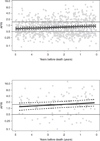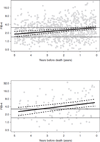Assessing mortality in women with hepatitis C virus and HIV using indirect markers of fibrosis
- PMID: 22156972
- PMCID: PMC3698040
- DOI: 10.1097/QAD.0b013e32834fa121
Assessing mortality in women with hepatitis C virus and HIV using indirect markers of fibrosis
Abstract
Objective: Co-infection with hepatitis C virus (HCV) is a major cause of morbidity and mortality in HIV-infected individuals. However, predictors of mortality are poorly defined and most studies have focused predominantly on co-infection in men. We evaluated whether two indirect markers of hepatic fibrosis, aspartate aminotransferase-to-platelet ratio index (APRI) and FIB-4 scores, were predictive of mortality in a well defined longitudinal cohort of HCV/HIV-co-infected women on HAART.
Methods: HCV/HIV-co-infected women on antiretroviral therapy enrolled in Women's Interagency HIV Study (WIHS), a National Institutes of Health-funded prospective, multicenter, cohort study of women with and at risk for HIV infection were included. Using Cox regression analysis, associations between APRI and FIB-4 with all-cause mortality were assessed.
Results: Four hundred and fifty HCV/HIV-co-infected women, of whom 191 women died, had a median follow-up of 6.6 years and 5739 WIHS visits. Compared with women with low APRI or FIB-4 levels, severe fibrosis was significantly associated with an increased risk of all-cause mortality {APRI: hazard ratio 2.78 [95% confidence interval (CI) 1.87, 4.12]; FIB-4: hazard ratio 2.58 (95% CI 1.68, 3.95)}. Crude death rates per 1000 patient-years increased with increasing liver fibrosis: 34.8 for mild, 51.3 for moderate and 167.9 for severe fibrosis as measured by FIB-4. Importantly, both APRI and FIB-4 increased during the 5 years prior to death for all women: the slope of increase was greater for women dying a liver-related death compared with nonliver-related death.
Conclusion: Both APRI and FIB-4 are independently associated with all-cause mortality in HCV/HIV-co-infected women and may have clinical prognostic utility among women with HIV and HCV.
Conflict of interest statement
There are no conflicts of interest involved in this manuscript.
Figures


Similar articles
-
Evaluation of liver fibrosis: concordance analysis between noninvasive scores (APRI and FIB-4) evolution and predictors in a cohort of HIV-infected patients without hepatitis C and B infection.Clin Infect Dis. 2011 May;52(9):1164-73. doi: 10.1093/cid/cir071. Clin Infect Dis. 2011. PMID: 21467023
-
Enhanced liver fibrosis marker as a noninvasive predictor of mortality in HIV/hepatitis C virus-coinfected women from a multicenter study of women with or at risk for HIV.AIDS. 2016 Mar 13;30(5):723-9. doi: 10.1097/QAD.0000000000000975. AIDS. 2016. PMID: 26595542 Free PMC article.
-
Elevated AST-to-platelet ratio index is associated with increased all-cause mortality among HIV-infected adults in Zambia.Liver Int. 2015 Jul;35(7):1886-92. doi: 10.1111/liv.12780. Epub 2015 Jan 22. Liver Int. 2015. PMID: 25581487 Free PMC article.
-
Performance of the aspartate aminotransferase-to-platelet ratio index for the staging of hepatitis C-related fibrosis: an updated meta-analysis.Hepatology. 2011 Mar;53(3):726-36. doi: 10.1002/hep.24105. Epub 2011 Feb 11. Hepatology. 2011. PMID: 21319189 Review.
-
HCV/ HIV co-infection: time to re-evaluate the role of HIV in the liver?J Viral Hepat. 2008 May;15(5):323-30. doi: 10.1111/j.1365-2893.2008.00970.x. Epub 2008 Jan 17. J Viral Hepat. 2008. PMID: 18208497 Free PMC article. Review.
Cited by
-
High Kynurenine:Tryptophan Ratio Is Associated With Liver Fibrosis in HIV-Monoinfected and HIV/Hepatitis C Virus-Coinfected Women.Open Forum Infect Dis. 2019 Jun 11;6(7):ofz281. doi: 10.1093/ofid/ofz281. eCollection 2019 Jul. Open Forum Infect Dis. 2019. PMID: 31304190 Free PMC article.
-
Marijuana Use Is Not Associated With Progression to Advanced Liver Fibrosis in HIV/Hepatitis C Virus-coinfected Women.Clin Infect Dis. 2016 Aug 15;63(4):512-8. doi: 10.1093/cid/ciw350. Epub 2016 May 25. Clin Infect Dis. 2016. PMID: 27225241 Free PMC article.
-
Prevalence and predictors of elevated aspartate aminotransferase-to-platelet ratio index in Latin American perinatally HIV-infected children.Pediatr Infect Dis J. 2014 Feb;33(2):177-82. doi: 10.1097/INF.0b013e3182a01dfb. Pediatr Infect Dis J. 2014. PMID: 23799515 Free PMC article.
-
Non-invasive tests for predicting liver outcomes in chronic hepatitis C patients: A systematic review and meta-analysis.World J Hepatol. 2021 Aug 27;13(8):949-968. doi: 10.4254/wjh.v13.i8.949. World J Hepatol. 2021. PMID: 34552701 Free PMC article.
-
The effect of HIV infection and HCV viremia on inflammatory mediators and hepatic injury-The Women's Interagency HIV Study.PLoS One. 2017 Sep 13;12(9):e0181004. doi: 10.1371/journal.pone.0181004. eCollection 2017. PLoS One. 2017. PMID: 28902848 Free PMC article.
References
-
- Graham CS, Baden LR, Yu E, Mrus JM, Carnie J, Heeren T, et al. Influence of human immunodeficiency virus infection on the course of hepatitis C virus infection: a meta-analysis. Clin Infect Dis. 2001;33:562–569. - PubMed
-
- Benhamou Y, Bochet M, Di MV, Charlotte F, Azria F, Coutellier A, et al. Liver fibrosis progression in human immunodeficiency virus and hepatitis C virus coinfected patients. The Multivirc Group. Hepatology. 1999;30:1054–1058. - PubMed
-
- Kenny-Walsh E. Clinical outcomes after hepatitis C infection from contaminated anti-D immune globulin. Irish Hepatology Research Group. N Engl J Med. 1999;340:1228–1233. - PubMed
-
- Weber R, Sabin CA, Friis-Moller N, Reiss P, El Sadr WM, Kirk O, et al. Liver-related deaths in persons infected with the human immunodeficiency virus: the D:A:D study. Arch Intern Med. 2006;166:1632–1641. - PubMed
Publication types
MeSH terms
Substances
Grants and funding
- U01-AI-42590/AI/NIAID NIH HHS/United States
- U01 AI031834/AI/NIAID NIH HHS/United States
- K23 66943/PHS HHS/United States
- K24 AI078884/AI/NIAID NIH HHS/United States
- U01 AI034989/AI/NIAID NIH HHS/United States
- U01-AI-34994/AI/NIAID NIH HHS/United States
- U01-AI-35004/AI/NIAID NIH HHS/United States
- U01-AI-31834/AI/NIAID NIH HHS/United States
- U01 AI034994/AI/NIAID NIH HHS/United States
- R21 A1088361/PHS HHS/United States
- U01 AI034993/AI/NIAID NIH HHS/United States
- U01 AI035004/AI/NIAID NIH HHS/United States
- U01-DH-32632/DH/BHP HRSA HHS/United States
- U01-AI-34993/AI/NIAID NIH HHS/United States
- R01 DK065515/DK/NIDDK NIH HHS/United States
- U01-AI-34989/AI/NIAID NIH HHS/United States
- U01 HD032632/HD/NICHD NIH HHS/United States
- U01 AI042590/AI/NIAID NIH HHS/United States
LinkOut - more resources
Full Text Sources
Medical

